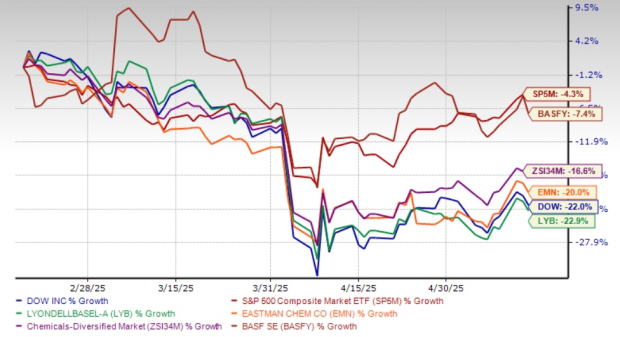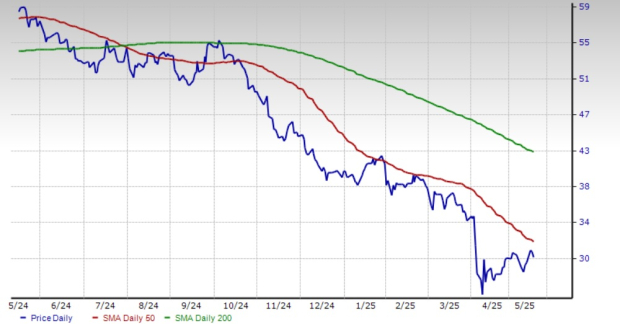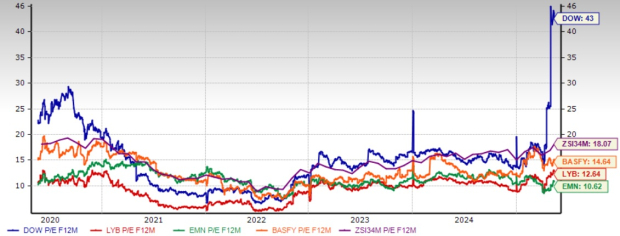|
|
|

|
|||||

|
|
Dow Inc.’s DOW shares have lost 22% in the past three months. The bearishness reflects headwinds from soft end-market demand amid an unfavorable macroeconomic environment and pricing pressure, which have weighed heavily on the stock.
Dow has underperformed the Zacks Chemicals Diversified industry’s 16.6% decline and the S&P 500’s fall of 4.3% over the past three months. Among its peers, LyondellBasell Industries N.V. LYB, Eastman Chemical Company EMN and BASF SE BASFY have lost 22.9%, 20% and 7.4%, respectively, over the same period.

Technical indicators show that DOW has been trading below the 200-day simple moving average (SMA) since Oct. 7, 2024. The stock is also currently trading below the 50-day SMA. Following a death crossover on July 29, 2024, the 50-day SMA continues to read lower than the 200-day SMA, indicating a bearish trend.

Given the pullback in Dow’s shares, investors might be tempted to snap up the stock. But is this the right time to buy DOW? Let’s find out -
DOW faces challenges from demand softness in Europe and China. Lower consumer spending amid inflationary pressures is affecting demand in Europe. Construction and manufacturing activities remain soft in the region. Demand in Asia has been affected by a weaker demand recovery in China. The property sector in China remains sluggish, with declining new home prices.
Demand in the infrastructure end market, including residential construction, remains weak. Inflationary pressures are hurting demand in consumer durables and building and construction. Dow sees softness in automotive in Europe due to low demand. Soft conditions across these markets are likely to weigh on volumes in the near term. Demand is expected to remain pressured by elevated inflation, low consumer confidence in Europe, and geopolitical tensions, particularly in building and construction and durable goods markets. Weak macroeconomic conditions due to disruptions caused by tariffs are expected to affect business and consumer sentiment in the near term.
Dow is also challenged by weak siloxane prices in its Performance Materials & Coatings unit. The segment continues to see siloxane pricing pressure partly due to supply additions in Asia. Lower local prices, due to sustained siloxane pricing weakness hurt the segment’s sales in the first quarter. Siloxane prices remain under pressure due to competitive pricing pressure resulting from additional supply driven by capacity additions in China. While capacity additions have slowed lately, elevated industry supply is expected to continue impacting prices in the near term.
DOW benefits from its differentiated portfolio and low-cost feedstock positions. It remains focused on investing in attractive areas through highly accretive projects. While Dow has delayed the construction of the Fort Saskatchewan Path2Zero project amid heightened macroeconomic and geopolitical uncertainties, it remains focused on growth actions in attractive end markets, including pharma and home and personal care, and completing high-return incremental growth projects in cost-advantaged regions. Its new alkoxylation expansion in Seadrift, TX, is expected to be fully operational by mid-2025. Dow expects the project to contribute to earnings upside in the second half of 2025.
The company is taking proactive actions amid a challenging environment that are expected to deliver roughly $6 billion in cash support. These include infrastructure asset sales, additional cost savings and reduced capital expenditures. The move is in response to the current macroeconomic challenges and to support its long-term growth targets. Dow is taking action to cut costs by $1 billion to drive margins. It expects to achieve the majority of the cost savings through reductions in direct and labor costs, including a workforce reduction of around 1,500 roles globally. Dow sees around $300 million in benefits from these actions in 2025, with full benefits expected by 2026. Dow also expects around $1 billion in capital expenditure reduction in 2025, with roughly a $600 million reduction projected through the delay in the Path2Zero project.
DOW has a strong balance sheet and generates substantial cash flows, which enable it to finance its growth investments in higher-value businesses and regions, and drive shareholder value. It ended the first quarter with solid liquidity of more than $11 billion, including cash and cash equivalents of roughly $1.5 billion. DOW returned $2.5 billion to its shareholders in 2024, comprising $2 billion in dividends and $0.5 billion in share buybacks. Dow also returned $494 million to its shareholders in the first quarter through dividends. It has no substantial long-term debt maturities until 2027.
DOW offers a healthy dividend yield of 9.1% at the current stock price, which is higher than 8.9% for LyondellBasell, 3.5% for BASF and 4% for Eastman Chemical. While DOW has a high payout ratio of 239%, its dividend is perceived to be safe and reliable, backed by strong cash flows and sound financial health.
The Zacks Consensus Estimate for DOW’s 2025 earnings has been going down over the past 60 days. The consensus estimate for second-quarter 2025 earnings has also been revised downward over the same time frame.

DOW is currently trading at a forward P/E of 43X, which represents a roughly 138% premium when stacked up with the industry average of 18.07X. DOW is trading at a significant premium to LyondellBasell, BASF and Eastman Chemical.

While DOW benefits from its cost and productivity actions, and investment in high-return projects, it is exposed to weak demand in a challenging environment as well as pricing headwinds, which have led to its underperformance. This, coupled with declining earnings estimates, casts a pall on the company's prospects. Its stretched valuation also might not offer an attractive entry point at this time. It is not advisable to buy the dip in this Zacks Rank #4 (Sell) stock until market conditions improve.
You can see the complete list of today’s Zacks #1 Rank (Strong Buy) stocks here.
Want the latest recommendations from Zacks Investment Research? Today, you can download 7 Best Stocks for the Next 30 Days. Click to get this free report
This article originally published on Zacks Investment Research (zacks.com).
| Dec-26 | |
| Dec-24 | |
| Dec-23 | |
| Dec-23 | |
| Dec-23 | |
| Dec-19 | |
| Dec-18 | |
| Dec-17 | |
| Dec-15 | |
| Dec-15 | |
| Dec-15 | |
| Dec-13 | |
| Dec-11 | |
| Dec-11 | |
| Dec-10 |
Join thousands of traders who make more informed decisions with our premium features. Real-time quotes, advanced visualizations, backtesting, and much more.
Learn more about FINVIZ*Elite